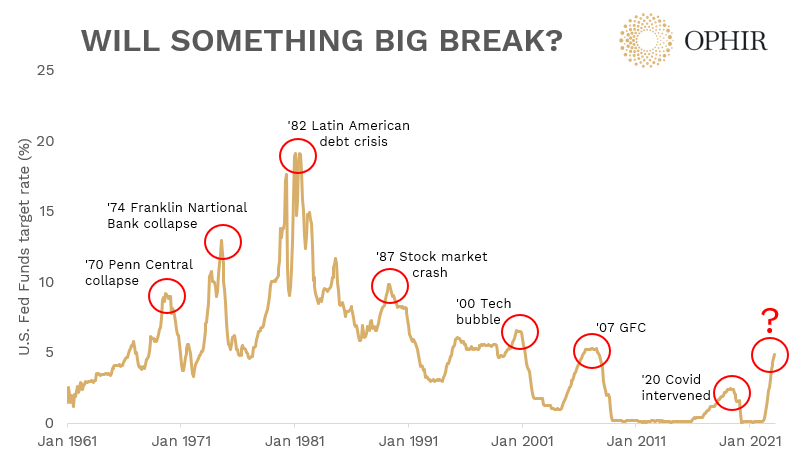Will something big break?
As someone who has spent a lot of time worrying about my clients’ portfolios during financial crises, you begin to recognise signs that lead up to these events.
One unmistakable signal is the end of a Fed interest rate hiking cycle.

The causes of financial crises are complex and multifaceted, but history clearly shows there is a link between crises and rising interest rates as the chart above illustrates.
As the old macro saying goes, economic “expansions don’t die of old age”. They often get killed by central banks, either directly or indirectly.
Potential reasons for this include:
- Low interest rates for an extended period leading to businesses and households taking on excessive amounts of debt or risk.
- Rising borrowing costs resulting in less cash flow available which can restrict options and create financial stress for businesses and households.
- Rotation of capital to less riskier investments which can lead to a decline in stock prices and liquidity.
One thing is clear, when interest rates have gone up considerably and well into restrictive territory, investors who have taken on too much risk can be exposed, leading to widespread panic and selling.
As Warren Buffett once said, "You never know who's swimming naked until the tide goes out."
So where are we in the current hiking cycle?
The market is forecasting a further and final 0.25% Fed hike by June before cuts most likely starting from September, with 0.50% in cuts forecasted this year.
This is a massive change from several weeks ago before the U.S. regional banking crisis where more than 1% of further rate hiking was priced.
Why the change? The market is saying financial tightening now will come from banks reducing loans instead of the Fed raising rates.
Some estimates have put the credit tightening equivalent to 1.5% of Fed hikes.
Regardless of whether you think the Fed did the right thing hiking in its last meeting, the fall in long-term bond yields in the last few of weeks has been a major positive in reducing the unrealised losses on bank’s balance sheets which is at the centre of the problem.
The question now is whether the collapse of SVB and Signature Bank is the crises that ends our current tightening cycle.
The market is currently saying not quite yet. But that will depend on if they’re the canary in the coalmine for other things breaking, or if the Fed can just go back to focussing on enemy No.1: inflation.

